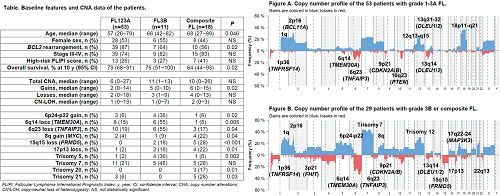
Contributions
Abstract: EP872
Type: E-Poster Presentation
Session title: Lymphoma Biology & Translational Research
Background
Grade 3B follicular lymphoma (FL3B) and composite FL (FL with a component of diffuse large B-cell lymphoma, DLBCL) exhibit specific biological and clinical features. Thus, gene expression profiling studies have suggested that FL3B is intimately related to FL3A, while FL3B/DLBCL would be closer to DLBCL. However, data concerning copy number alterations (CNA) of these histologies are scarce.
Aims
To characterize the copy number profile of FL3B and composite FL, and to compare it with that of FL123A.
Methods
We selected 29 patients with FL3B (n=11) or composite FL (n=18), as well as a control group of 53 patients with grades 1-3A FL. Composite cases were further subclassified into FL123A/DLBCL (C123A, n=10) and FL3B/DLBCL (C3B, n=8). All biopsies were reviewed by at least two hematopathologists. Minimal common CNA regions were defined separately for FL123A and FL3B/C123A/C3B cases. DNA was extracted from diagnostic formalin-fixed, paraffin embedded lymph node biopsies. CNA were assessed using the OncoScan CNV Assay (Thermofisher). The BCL2 rearrangement was analyzed by FISH and/or PCR. Non-parametric statistics were used for comparisons of categorical and quantitative variables.
Results
Baseline features of the patients and CNA of the samples are detailed in the Table. BCL2 rearrangement was more frequent in FL123A (87%) than in FL3B (64%) or composite FL cases (56%, P=0.02). We detected CNA in 78/82 samples (95%). Although no significant differences were found in the total number of CNA among groups, the number of gains was higher in FL3B (median, 5) and composite FL (median, 6) compared to FL123A cases (median, 2; P=0.02). The most frequent CNA among the 82 samples were 1q gain (n=22, 27%), trisomy 7 (n=21, 26%), and 1p36 copy-neutral loss of heterozygosity (n=20, 24%).
Figure A shows the CNA profile of FL123A, and Figure B that of FL3B and composite FL. Several CNA showed a different distribution among FL123A, FL3B, and composite FL cases. Of note, losses of 6q13-q15 (TMEM30A) and 6q23-q15 (TNFAIP3) were more frequent in FL3B cases (n=6, 55%). We then compared composite FL cases according to the FL component (FL123A vs FL3B) and found no significant differences, with the exception of trisomy 12, which was observed in four C3B and none of the C123A cases (P=0.02).

Conclusion
In this CNA analysis of 29 FL3B/C123A/C3B and 53 FL123A samples, 1q gain and trisomy 7 were the most frequent abnormalities. FL123A cases had a lower number of gains, and several alterations showed a differential distribution among histological subgroups. Further studies, including targeted NGS, are under way to deepen the understanding of these specific FL subtypes.
Keyword(s): Follicular lymphoma, Genomics
Abstract: EP872
Type: E-Poster Presentation
Session title: Lymphoma Biology & Translational Research
Background
Grade 3B follicular lymphoma (FL3B) and composite FL (FL with a component of diffuse large B-cell lymphoma, DLBCL) exhibit specific biological and clinical features. Thus, gene expression profiling studies have suggested that FL3B is intimately related to FL3A, while FL3B/DLBCL would be closer to DLBCL. However, data concerning copy number alterations (CNA) of these histologies are scarce.
Aims
To characterize the copy number profile of FL3B and composite FL, and to compare it with that of FL123A.
Methods
We selected 29 patients with FL3B (n=11) or composite FL (n=18), as well as a control group of 53 patients with grades 1-3A FL. Composite cases were further subclassified into FL123A/DLBCL (C123A, n=10) and FL3B/DLBCL (C3B, n=8). All biopsies were reviewed by at least two hematopathologists. Minimal common CNA regions were defined separately for FL123A and FL3B/C123A/C3B cases. DNA was extracted from diagnostic formalin-fixed, paraffin embedded lymph node biopsies. CNA were assessed using the OncoScan CNV Assay (Thermofisher). The BCL2 rearrangement was analyzed by FISH and/or PCR. Non-parametric statistics were used for comparisons of categorical and quantitative variables.
Results
Baseline features of the patients and CNA of the samples are detailed in the Table. BCL2 rearrangement was more frequent in FL123A (87%) than in FL3B (64%) or composite FL cases (56%, P=0.02). We detected CNA in 78/82 samples (95%). Although no significant differences were found in the total number of CNA among groups, the number of gains was higher in FL3B (median, 5) and composite FL (median, 6) compared to FL123A cases (median, 2; P=0.02). The most frequent CNA among the 82 samples were 1q gain (n=22, 27%), trisomy 7 (n=21, 26%), and 1p36 copy-neutral loss of heterozygosity (n=20, 24%).
Figure A shows the CNA profile of FL123A, and Figure B that of FL3B and composite FL. Several CNA showed a different distribution among FL123A, FL3B, and composite FL cases. Of note, losses of 6q13-q15 (TMEM30A) and 6q23-q15 (TNFAIP3) were more frequent in FL3B cases (n=6, 55%). We then compared composite FL cases according to the FL component (FL123A vs FL3B) and found no significant differences, with the exception of trisomy 12, which was observed in four C3B and none of the C123A cases (P=0.02).

Conclusion
In this CNA analysis of 29 FL3B/C123A/C3B and 53 FL123A samples, 1q gain and trisomy 7 were the most frequent abnormalities. FL123A cases had a lower number of gains, and several alterations showed a differential distribution among histological subgroups. Further studies, including targeted NGS, are under way to deepen the understanding of these specific FL subtypes.
Keyword(s): Follicular lymphoma, Genomics


